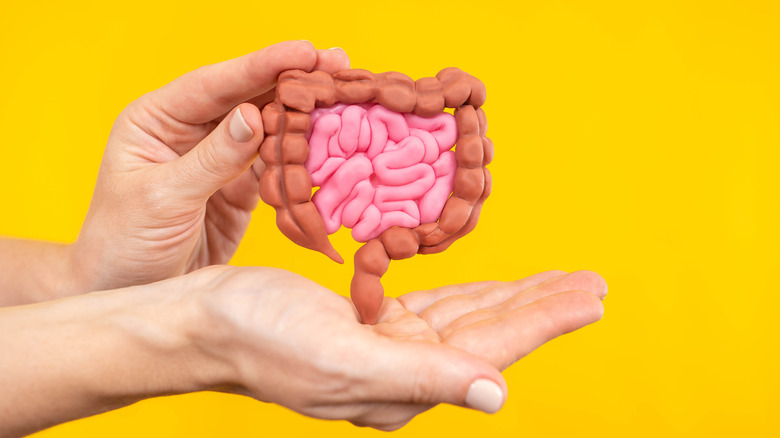The Ayurvedic Belly Massage That Can Help With Digestion
Ayurveda — one of the oldest natural systems of medicine — originated during the Vedic period in India over 5,000 years ago (per Food & Nutrition). It continues to be used today, particularly in the Eastern world, as either the exclusive form of healthcare for individuals or in tandem with more modern medical practices. A 2016 article published in the journal AYU, states that the root "Ayus" means life, and "Veda" means science and knowledge, making the term Ayurveda translate to "the science of life."
As is described by the University of Minnesota, at its core, Ayurveda is about cultivating wellness by maintaining the balance between the mind, body, and spirit. It is believed that illness can be prevented or healed by harnessing the power of herbs, maintaining a healthy diet, practicing yoga, meditating, fostering happy and functional relationships, and using massage to keep energy flowing through the body, as it should.
How a belly massage can help with digestion
Abhyanga, a type of warm oil massage that has a special place in the world of Ayurvedic medicine, is often implemented as a daily ritual before bathing (per Mindbodygreen). Healthline notes that while abhyanga can be performed by an ayurvedic practitioner, it is also widely done by oneself.
Abhyanga massage is believed to promote overall wellness, and may also offer a multitude of specific health benefits, including reduced stress, lowered blood pressure, reduced muscle stiffness, and improved skin health. It has also been associated with the activation of the parasympathetic nervous system, also known as the "rest and digest" system, as it triggers functions like digestion. When speaking with Mindbodygreen, Ayurvedic practitioner Dr. Avanti Kumar-Singh describes how centralized belly massage can also relax tense myofascial muscles in the abdomen so that waste can move through with a greater sense of ease.
How to give yourself an Anhyanga belly massage
Like with most everything in the practice of Ayurveda, the details matter...even down to the oil you use for your self-massage. Depending on your dosha type, you might decide to use sesame, sunflower, safflower, or sweet almond oil (per Healthline.) Once you've decided which oil works best for your constitution, warm the oil by gently rubbing it between your hands (per Mindbodygreen). When the oil is comfortably warm, put your hands on your abdomen.
A 2020 review published in the World Journal of Pharmaceutical Research notes that when performing abhyanga on the umbilicus region, or navel, it is important to move in a circular motion. Mindbodygreen recommends beginning to gently massage the left lower belly, slowly moving towards the right. From there, almost like you're tracing your large intestine with your fingers, slide your hands up your right side to the bottom of your rib cage, over to the left side, and then back down to the left lower belly where you started. Repeat these circular motions for a few minutes before rinsing off in a warm shower or bath.



